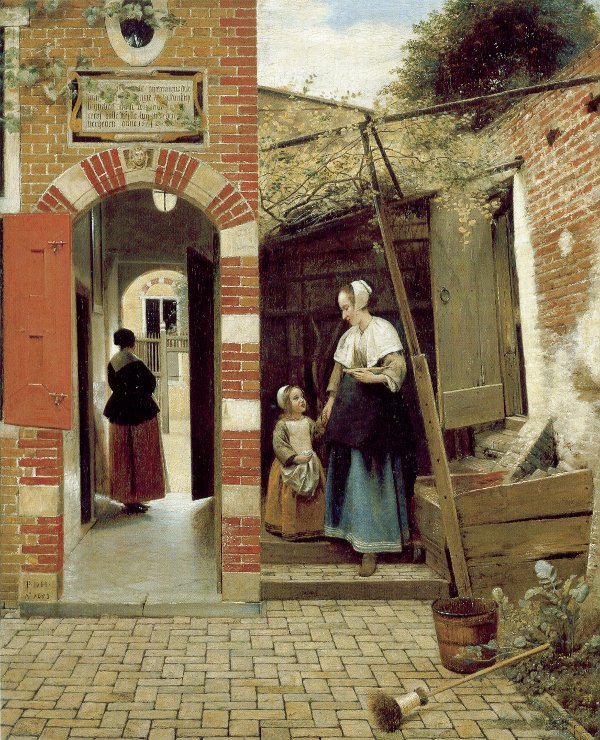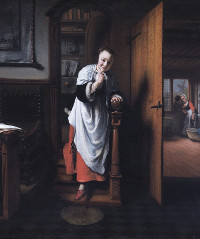Essential Vermeer Newsletter no. 41
December 2019
December 2019
Click here to access this newsletter as a SIMPLE TEXT document.
IN BRIEF :
1. Restoration of Vermeer's Girl Reading a Letter at an Open Window reveals spectacular surprise
3. Major overhaul: Essential Vermeer goes responsive
4. The National Gallery's Lady Seated Seated at a Virginal travels to to Australia in late 2020
5. Pieter de Hooch in Delft: From the Shadow of Vermeer | Delft, 11 October 2019–16 February 2020
6. Nicolaes Maes - Rembrandt’s Versatile Pupil | Mauritshuis, 17 October 2019–19 January 2020
Please remember the Essential Vermeer when you change your email address!

An x-ray photograph taken decades ago revealed that behind the solitary female figure in Vermeer's Girl Reading a Letter by an Open Window the artist had originally incorporated a large ebony-framed “painting-within-a-painting” of a pot-belied Cupid. It was believed that the artist himself, unsatisfied with the results, presumably painted out the picture in order to nuance the painting's iconographic significance and/or improve the composition equilibrium.
However, the ongoing investigation and restoration of the painting Dresden Gemäldegalerie Alte Meister has been proven that the overpainting was not done by Vermeer himself but, unexpectedly, by a different hand some years after the completion of the work. It has not yet been possible to identify who or what point after the painting left Vermeer's studio time the alteration was performed, although Uta Neidhardt, the senior conservator at Dresden’s Gemäldegalerie, told The Art Newspaper:
There was even a layer of dirt above the original varnish on the Cupid, showing the painting had been in its original state for decades. [. . .] This is the most sensational experience of my career [. . .] It makes it a different painting.
In conformance with the new findings, the Gemäldegalerie decided to remove the layer of gray paint which obscures such a major background element and thus restore it the artist's original intention.
For a short period of about 5 weeks the painting can now be enjoyed in a special studio presentation at the Gemäldegalerie, from May 8 to June 16.
The restoration is taking place in the paintings conservation department at the Staatliche Kunstsammlungen Dresden and is being performed by paintings conservator Dr. Christoph Schölzel. Accompanying the restoration is a research project about the painting, carried out in cooperation with the archaeometry laboratory at the Hochschule für Bildende Künste Dresden, the Doerner-Institut at the Bayerische Staatsgemäldesammlungen München, the Rijksmuseum Amsterdam and The National Gallery in London.
At the outset of the restoration, a symposium was held in March 2017 with specialists from Amsterdam, Copenhagen, Vienna and Dresden, who have investigated and restored works by Vermeer in the past years. They were invited by the Dresden Gemäldegalerie and will continue to accompany the conservation project and provide their professional input.
After completing the restoration of Vermeer’s Girl Reading a Letter at an Open Window, the painting is scheduled to be shown again to the visitors from March, 2020.
For videos, further information and images regarding on the restoration of the painting, visit the Gemäldegalerie dedicated webpage.
https://gemaeldegalerie.skd.museum/en/research/vermeer/
Click here to access the article.

In a recent paper, Huib Zuidervaart, of the History of Science Department of the Huygens Institute for the History of the Netherlands, has advanced an interesting theory on the origin of Vermeer's Glass of Wine and the The Girl with a Wine Glass. Zuidervaart asserts that the two works, which represent an open window that features an identical coat of arms, were commissioned as wedding presents for two of the grandchildren of Moijses van Nederveen and Janetge de Vogel. Moijses van Nederveen came from of a prominent Delft family which was one of the four local producers of gunpowder, delivered to the Dutch army. Although historians had previously identified the families to which the coat or arms belonged—the heraldic emblem is a combination of those belonging to the Van Nederveen and De Vogel families—no one had as of yet explained why Vermeer would have chose to include such a conspicuous elements into two ambitious compositions. Zuidervaart points out that dates given to both paintings by Vermeer experts coincide with the dates of the weddings in question. Moreover, the symbolic implications of the coat of arms (figure of female virtue holding a crest) would appear in agreement with the idea as a wedding gift as well as being consistent with the background of Vermeer's presumed clients. Given that both paintings present not only the same window but the same set of ceramic tiles, which Vermeer never painted again, it is also possible that the Delft master executed both works on the premises of the Van Nederveen/De Vogel residence in Delft.
Click here to download PDF.
Mr. Zuidervaart's paper, "Een nieuwe theorie over twee schilderijen van Johannes Vermeer (1632–1675)" published in Jaarboek Delfia Batavorum 28 (2018).
In the course of 2019 Essential Vermeer has undergone a deep and thorough overhaul. The primary goal was to improve the user interface in order to provide visitors with an ever-more meaningful experience of the art and times of Johannes Vermeer. One of the most significant improvements adopting Bootstrap 4, a state-of-the-art responsive framework that affords users optimal viewing across a full range of devices, from large desktop monitors to hand-held smart phones. This framework also provides numerous components that facilitate navigation and enhance viewing. Among the many changes, the former gray background has been replaced with a clean white background so that the finer nuances of the site's thousands of digital images become more apparent, and, combined with a larger typeface and a higher contrast in font color, readability is greatly improved. The basic page layout has been streamlined from the three-column layout to a single, central column. Many images were replaced by up-to-date high-resolution counterparts. Of particular notice, the 37 pages backbone Interactive Vermeer Catalogue are now richer in content and more viewer friendly.

Botticelli to Van Gogh: Masterpieces from the National Gallery
November 13, 2020–March 14, 2021
National Gallery of Australia, Canberra
https://nga.gov.au/masterpieces/

Spanning 450 years, Botticelli to Van Gogh: Masterpieces from the National Gallery presents more than 60 paintings by some of Europe’s most revered artists, including Titian, Rembrandt, Vermeer, Velázquez, Goya, Turner, Renoir, Cézanne and Gauguin. Exclusive to Canberra, it comprises the largest group of works to travel outside of the United Kingdom in the history of the National Gallery, London.
The exhibition explores seven key periods in Western European art history: the Italian Renaissance, Dutch painting of the Golden Age, Van Dyck and British portraiture, the Grand Tour, Spanish art from the seventeenth century, landscape and the picturesque and the birth of modern art.
Highlights include Rembrandt’s Self Portrait at the Age of 34 1640, Vermeer’s A Lady Seated at a Virginal and Van Gogh’s Sunflowers 1888.
October 11, 2019–February 16, 2020
Museum Prinsenh, Delft
T +31 (0)15 260 23 58
https://prinsenhof-delft.nl/pieterdehooch/?lang=en

The exhibition is the first retrospective of the artist’s work in his own country. After Vermeer, Pieter de Hooch is widely considered to be the most celebrated Delft master of the 17th century. The paintings De Hooch produced in Delft (c. 1652–1660) will be at the heart of the exhibition: his most beautiful courtyards and interiors will return to the city where they were painted almost 400 years ago.
Twenty-nine works will be coming to Delft on loan from leading museums in Europe and the United States. These include many famous paintings never before exhibited in the Netherlands such as the well-known Courtyard of a House in Delft from the National Gallery, London. Other Pieter de Hooch masterpieces will come from Museo Thyssen-Bornemisza, Madrid, the Kunsthaus Zürich and the National Gallery of Art in Washington. An extraordinary work on loan from the Royal Collection of Her Majesty Queen Elizabeth II is the masterpiece Cardplayers in a Sunlit Room. In addition, the exhibition will comprise works on loan from the Mauritshuis, the Museum Boijmans van Beuningen, the Amsterdam Museum and of course the Rijksmuseum, which holds one of the largest collections of De Hooch paintings in the world.
Mauritshuis, The Hague
October 17, 2019–January 19, 2020
https://www.mauritshuis.nl/en/discover/exhibitions/nicolaes-maes/

Concluding the Rembrandt & the Golden Age year the Mauritshuis will stage the first international retrospective exhibition about one of Rembrandt's most talented students, Nicolaes Maes.
With his original representations of everyday life, Nicolaes Maes was one of the most innovative painters of the Dutch Golden Age. His domestic scenes have been a source of inspiration for painters such as Pieter de Hooch and Johannes Vermeer. In his lifelike representation of emotions, Maes shows himself to be a fully fledged student of Rembrandt.
Maes began his career by painting Biblical stories, in which the influence of his teacher is clearly visible. Rembrandt was a dedicated teacher who challenged his pupils to be inventive and come up with new things. Maes was inspired by his teacher, but at the same time always looked for his own, new solutions. This can be clearly seen in The Sacrifice of Isaac (c. 1653). Maes gave this Biblical theme an explosive charge.
In the following years, Maes painted intimate scenes with women engaged in their household duties. The eavesdroppers are a favorite; representations of how the lady of the house catches her maid with a lover. Roguishly and conspiratorially, the woman looks at us; with her finger on her lips she draws the attention of the viewer and calls for silence. Some beautiful "eavesdroppers" will be on loan from the Dordrechts Museum, the Guildhall Art Gallery and the Wellington Museum (both London).
The second venue of the exhibition will be held at the National Gallery, London,
22 February – 31 May 2020.
If you discover a  or anything else that isn't working as it should be, I'd love to hear it! Please write me at: jonathanjanson@essentialvermeer.com
or anything else that isn't working as it should be, I'd love to hear it! Please write me at: jonathanjanson@essentialvermeer.com